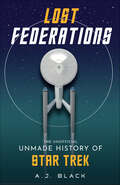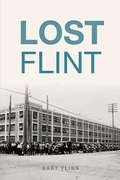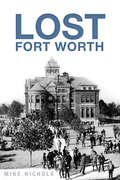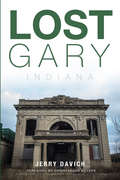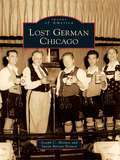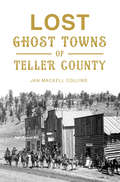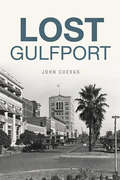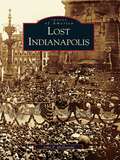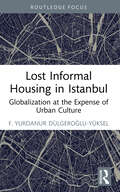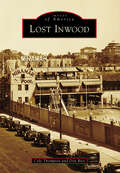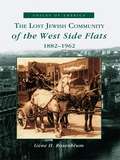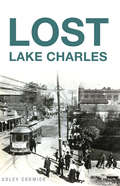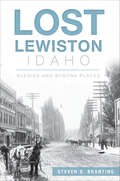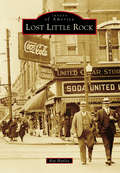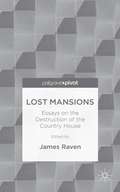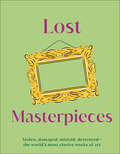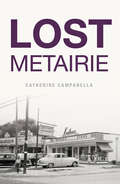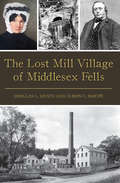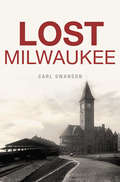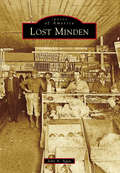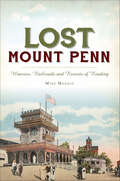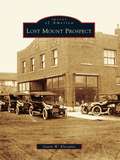- Table View
- List View
Lost Federations: The Unofficial Unmade History of Star Trek
by A. J. Black"An innovative and unusual account of Star Trek’s lost voyages that makes for a fascinating alternate history." — Brian J. Robb in Sci-Fi Bulletin SPACE. THE FINAL FRONTIER. THESE WERE ALMOST THE VOYAGES OF THE STARSHIP ENTERPRISE. We think we know the history of Star Trek. Born at the height of 1960s popular culture, the five-year mission of Captain James T. Kirk and his crew faced early cancellation, bounced back with a series of beloved movies in the 1980s and gave way to a fleet of successful sequels and spin-offs that kept on exploring strange new worlds. In Lost Federations: The Unofficial Unmade History of Star Trek, author A. J. Black tells a different story. This is an alternate history of the franchise, one filled with roads not taken, from early 1960s feature-films and spin-offs, the original sequel Star Trek: Phase II in the 1970s, via epic planned movies such as Planet of the Titans and into many untold episodes, arcs and character stories from The Next Generation, Deep Space Nine and Voyager, all the way through to the modern era. Bringing together pre-existing material over decades for the first time in one space, plus some new reflections from Star Trek writers and analysis of how it all fits into the wider cultural trends of the last sixty years, Lost Federations invites you to boldly explore a history you may not already know...
Lost Flint (Lost)
by Gary FlinnThe city of Flint waxed and waned with the automotive industry of the twentieth century. Where they have not vanished completely, crumbling signs of past opulence stand as painful reminders of more recent struggles. Hardly a trace remains of the Buick City factory complex that sprawled across the city's north side. The placid waters of Flint Park Lake once echoed with the sounds of an amusement park--games, dancing, circus acts and even a roller coaster. Flint Community Schools pioneered a model for how schools can function outside regular hours, but too many now are closed and deteriorating. Local author Gary Flinn uncovers the abandoned places and lost traditions from the Vehicle City's past.
Lost Fort Worth (Lost)
by Mike NicholsFrom the humble beginnings of a frontier army camp, Fort Worth transformed into a city as cattle drives, railroads, oil and national defense drove its economy. During the tremendous growth, the landscape and cultural imprint of the city changed drastically, and much of Cowtown was lost to history. Witness the birth of western swing music and the death of a cloud dancer. See mansions of the well-heeled and saloons of the well-armed. Meet two gunfighters, one flamboyant preacher, one serial killer and one very short subway carrying passengers back in time to discover more of Fort Worth. Author Mike Nichols presents a colorful history tour from the North Side to the South Side's Battle of Buttermilk Junction.
Lost Gary, Indiana (Lost)
by Jerry DavichA poster child for our nation's urban experimentation a century ago, Gary was forged with hype and hope, dreams and sweat, political agendas and tons of steel. The hardscrabble city attracted all kinds, from shady scoundrels and famous architects to hardworking immigrants and brilliant entrepreneurs. Boasting 180,000 residents at its peak, the booming melting pot eventually faded away under the afflictions of urban decay, racial unrest and political upheaval. Jerry Davich explores the remnants of Gary's glory days, from Union Station in ruins to City Methodist Church stripped of its soul. Revisit the Sheraton Hotel's demise, Emerson High School's hard lessons, Vee-Jay Records' last release and a devastated downtown filled only with façades and fond memories.
Lost German Chicago (Images of America)
by Joseph C. Heinen Susan Barton HeinenBy 1900, one in four Chicagoans was either German born or had a German-born parent. No other ethnic group's thumbprint has been larger in helping establish Chicago as a major economic and cultural center nor has any group's influence been more erased by the passage and vicissitudes of time. Lost German Chicago traces the mosaic of German life through the tumultuous events of the Beer Riots, Haymarket Affair, Prohibition, and America's entry into two world wars. The book is a companion piece to the Lost German Chicago exhibition debuting in the newly created DANK-Haus German American Cultural Center museum, located in what is still known today as the "German town" of the north side of Chicago. Entrusted as the caretaker of many archives, artifacts, and historical documents from many now defunct German organizations, the DANK-Haus German American Cultural Center has been committed to preserving history, traditions, and contributions of Germans and German Americans for over 50 years.
Lost Ghost Towns of Teller County (Lost)
by Jan Mackell CollinsThroughout Teller County, history lovers can find abandoned towns and forgotten main streets that once bustled with life and commerce. Even before Teller was carved from surrounding counties, the scenic mountains and lucrative mines of the gold rush era brought thousands of settlers and attracted resort owners and tycoons eager to exploit the rich setting. Seemingly overnight, towns in the Cripple Creek District and other places popped up, flush with gold and people looking for opportunity. As the ore disappeared, the miners moved on in search of the next big lode. One by one, the towns were all but forgotten. Join Jan MacKell Collins and discover the booming history, lost towns and hardy settlers of Teller County.
Lost Gulfport (Lost)
by John CuevasThe second largest city in the state, Gulfport is the business center of south Mississippi. Many of the city's cherished landmarks and businesses have been lost to Hurricanes Camille and Katrina, the development of shopping malls and Interstate 10. Gulfport's answer to the quintessential '50s malt shop, Stone's Ice Cream, became a favorite hangout for students, families and businessmen throughout its long history. The Paramount Theatre was famous for its annual Christmas raffle during the '50s. Known as the "Hosts of the Gulf Coast," the Friendship House Restaurant served up a great cup of coffee along with its celebrated Hospitality Menu. Historian John Cuevas takes a look back at Gulfport's shops, restaurants, nightclubs, cinemas and more from a bygone age.
Lost History: The Enduring Legacy of Muslim Scientists, Thinkers, and Artists
by Michael Hamilton MorganIn an era when the relationship between Islam and the West seems mainly defined by mistrust and misunderstanding, it is important to remember that for centuries Muslim civilization was the envy of the world. Lost History fills a significant void and is essential reading for anyone seeking to understand the major the early Muslims played in influencing modern society. Morgan reveals how early Muslim advancements in science and culture laid the cornerstones of the European Renaissance, the Enlightenment, and modern Western society. As he chronicles the Golden Ages of Islam, beginning in A.D. 570 with the birth of Muhammad, and resonating today, he introduces scholars like Ibn Al-Haytham, Ibn Sina, Al-Tusi, Al-Khwarizmi, and Omar Khayyam, towering figures who revolutionized the mathematics, astronomy, and medicine of their time and paved the way for Newton, Copernicus, and many others. And he reminds us that inspired leaders from Muhammad to Suleiman the Magnificent and beyond championed religious tolerance, encouraged intellectual inquiry, and sponsored artistic, architectural, and literary works that still dazzle us with their brilliance. Lost History finally affords pioneering leaders with the proper credit and respect they so richly deserve.
Lost Indianapolis
by John P. McdonaldIn 1816, the U.S. Congress decided to give the newly formed State of Indiana four square miles of land to lay out a capital city. Just where the capital city would be platted, however, was unknown. Four years later, the spot was finally chosen near where Fall Creek meets the White River. From that moment forward, despite a few bumps along the way, Indianapolis began its development into one of the nation's great cities. Over the course of that development, many buildings, companies, legends, and people have come and gone. While they are now only shadows of the past, they help to form the history and heart of Indianapolis.
Lost Informal Housing in Istanbul: Globalization at the Expense of Urban Culture
by F. Yurdanur Dulgeroglu-YukselThe dynamics of globalization brought a radical change in megacities and tensions between the stakeholders and dwellers against top-down urban renewal policies. This unique book provides a worldview of multi-stakeholders in the urban housing market. With a longitudinal research approach, it paves the way for interdisciplinary researchers to critically assess the urban renewal projects and update such studies. The urban renewal processes are implemented without participation, and the book highlights field-based information for policymakers. The reader will find, with the information provided from the field, why participation is necessary for a sustainable urban development, why there are different types of urbanizations, and how it works under different conditions. Better understanding of the challenges of urban renewal processes in the world cities is intended with the focus on the changing informal settlements. Istanbul is a megacity, housing more than half of its dwellers in informal settlements. After many decades of self-upgrading and silently communicating with the local authorities, the informal sector had become adapted and maintained its living spaces. Unexpectedly, the end of the first decade of the 21st century marked a radical urban land valuation and international investments. Top-down interventions started with naming Istanbul the 2010 European Capital of Culture. Then came the Law of Urban Transformation, which meant the fast decline of squatter housing and the speedy loss of its cultural value of the mahalle spirit, place identity. The book will raise curiosity on why the time has come to change the perspectives about the informal urban sector.
Lost Inwood (Images of America)
by Cole Thompson Don RiceInwood, the northernmost neighborhood of Manhattan, has a rich yet little-known history. For centuries, the region remained practically unchanged--a quaint, country village known to early Dutch settlers as Tubby Hook. The subway's arrival in the early 1900s transformed the area, once scorned as "ten miles from a beefsteak," from farm to city virtually overnight. The same construction boom sparked an age of neighborhood self-discovery, when vestiges of the past--in the form of mastodon bones, arrowheads, colonial pottery, Revolutionary War cannonballs, and forgotten cemeteries--emerged from the earth. Waves of German, Irish, and Dominican immigrants subsequently produced a vibrant urban oasis with a big-city/small-town feel. Inwood has also been home to wealthy country estates, pre-integration sports arenas, and a lively waterfront culture. Famous residents have included NBA legend Kareem Abdul-Jabbar, Basketball Diaries author Jim Carroll, and Hamilton creator/star Lin-Manuel Miranda.
Lost Jewish Community of the West Side Flats 1882-1962, The: 1882-1962 (Voices of America)
by Gene H. RosenblumBeginning in 1882, many Russian and Eastern-European Jews who fled to the United States settled in the "West Side Flats" in St. Paul, Minnesota. The area once stretched from the banks of the Mississippi River to the cliffs of the West Side Hills, about 320 acres in all, but has since fallen victim to the vagaries of the mighty river and the progress of "urban renewal." The Lost Jewish Community of the West Side Flats: 1882-1962 takes the reader on a pictorial tour down memory lane. The families, houses, businesses, streets, and synagogues-all vanished now-are brought back to life through vintage photographs from the archives of the Jewish Historical Society of the Upper Midwest, the Minnesota Historical Society, and the private collections of many former residents. This is a memoir of a historic neighborhood that can no longer be visited.
Lost Lake Charles (Lost)
by Adley CormierFires, hurricanes, neglect and progress erased much of Lake Charles’s physical history. The young town was a magnet for pirates and privateers, like the infamous Jean Lafitte, who conducted business at the mouth of what is today called the Contraband Bayou. Michigan Men, creoles and cowboys made their way to the fledgling Louisiana town to start new lives. A great lumber industry shaped the town in the nineteenth century. Streetcars ran routes around the clock seven days a week. Author and historian Adley Cormier delves deep into Lake Charles’s past to uncover a history that has been lost to time and change.
Lost Lake Erie (Lost)
by Jennifer Boresz EngelkingSerene one moment and destructive the next, Lake Erie's moods mirror its tumultuous role in history. As the site of Cleveland's Great Lakes Exposition, the lake offered visitors a respite from the Great Depression, and Hotel Victory, once considered the world's largest summer resort, drew thousands to Put-In-Bay. Daring postal workers dangerously crossed the ice-covered surface on hybrid "boats" and by foot. Canal Street, at the Buffalo Wharf, was once called "the Wickedest Street in America." The Erie is one of thousands of ships that lie in a solemn graveyard below the surface. And rum runners turned the lake into a watery highway for illegal booze during Prohibition. Author Jennifer Boresz Engelking reveals entertaining, heartbreaking, and nostalgic stories of the lost sites, businesses and industries of Lake Erie.
Lost Lewiston, Idaho: Elegies and Bygone Places (Lost)
by Steven D. BrantingLewiston has a proud heritage of historic preservation. Yet, as with other communities, it has neglected and thrown away once-treasured landmarks and precious memories with the passage of time. Some legacies were crafted with brick and mortar, others with flesh and blood. Nothing is permanent unless we make it so. Join award-winning historian Steven D. Branting as he takes a focused look at some of Lewiston's bygone edifices and the ambitious civic leaders and craftsmen who fashioned them. Reconnect with the city's scholars, its pious, its dreamers and one desperate teenager. They all made Lewiston what it once was, bequeathed their present to be our past and have sadly faded from our view.
Lost Little Rock
by Ray HanleyLittle Rock is a sprawling city of about 200,000 at the center of a metropolitan area of more than 500,000 people, with many residing in bedroom communities in adjoining counties. Arkansas's capital city is much like the rest of Middle America with its outlying suburbs, gated communities, and shopping centers miles from the historic core. A century ago, however, Little Rock was markedly different and served a population of fewer than 50,000. The majority of citizens lived within blocks of the town center and did business downtown along rows of shops that, in many cases, dated to the late 1800s. Images of America: Lost Little Rock uses vintage photographs to reflect upon earlier times and the rich retail landscape that once filled the town. By exploring the legacies of buildings that have since been demolished, repurposed, or destroyed by fire, these images provide a sense of Little Rock's lesser-known heritage.
Lost Mansions: Essays on the Destruction of the Country House
by James RavenThis provocative volume stimulates debate about lost 'heritage' by examining the history of the hundreds of great houses demolished in Britain and Ireland in the twentieth century. Seven lively essays debate our understanding of what is meant by loss and how it relates to popular conceptions of the great house.
Lost Masterpieces: The World's Forgotten Masterpieces, from Stolen to Destroyed
by DKDiscover the extraordinary stories behind the world&’s missing works of art.Travel back in time to discover works of art that have vanished from the record, as well as those that went missing and have since been reclaimed or recovered. From the treasures of Tutankhamun to the altarpiece of Ghent, a missing Fabergé egg, and Vincent van Gogh&’s majestic Sunset at Montmajour, numerous masterpieces have disappeared throughout history as a result of theft, looting, natural catastrophe, or conflict… And some have resurfaced decades or even centuries later!Lost Masterpieces examines the unique story of the most significant of these artworks, the artists who created them, and those thought to be involved in their loss. It explores the various means by which museum curators and international crime investigators have unearthed missing treasures. It highlights the moral dilemma of museums that have profited from looted works of art and examines the recent &“heists&” made by some nations in an effort to regain their nation&’s stolen works of art.This awe-inspiring art history book promises:- A selection of the most important &“lost&” cultural artifacts from ancient times to the present day- Features images of the artworks where available, or specially commissioned illustrations of them based on written accounts-Includes details of the ongoing debate about whether looted art should be returned to its country of originDelve into the mysteries of ancient Egyptian tombs, marvel at the hoards unearthed by archaeologists, and discover the skulduggery behind the disappearance of priceless Rembrandts and Vermeers, and see the world of art and antiquities in a whole new light! A must-have volume for adults and young adults with an interest in art, culture and history, whether you&’re an art or history student, a collector of art antiques, or you&’re simply a curious lifelong learner, Lost Masterpieces is sure to delight.
Lost Metairie (Lost)
by Catherine CampanellaFrom ancient bayous to beloved old businesses, Metairie has changed dramatically over generations. And many of those landmarks are lost to time. The lake, railroads and a beach resort were popular features in the early days. A streetcar ran through the short-lived City of Metairie Ridge, where gambling houses and dog tracks contributed more tax dollars than did the few residents. Old Bucktown was famous for its seafood. Fat City, once notorious for its nightlife, has seen better days. Author Catherine Campanella takes a look back at the schools, shops, bars, restaurants, alligator farms, bowling alleys, drive-ins and movie theaters from a bygone era.
Lost Mill Village of Middlesex Fells, The (Brief History)
by Alison C. Simcox Douglas L. HeathOne of the earliest mill communities in the Massachusetts Bay Colony formed along Spot Pond Brook, a few miles north of Boston. Thomas Coytmore built the first mill in 1640 at the brook’s downstream end in “Mistick Side” (present-day Malden). Other mills sprang up along the brook as well. Today, most of Spot Pond Brook is hidden in culverts beneath the busy streets of Malden and Melrose. However, remnants of the lost mill village of Haywardville—foundations, millruns and ponds and waterfalls—are preserved within Middlesex Fells Reservation, part of Boston’s world-famous Metropolitan Park System. Authors Douglas L. Heath and Alison C. Simcox trace the history of this thriving early American community.
Lost Milwaukee (Lost)
by Carl SwansonFrom City Hall to the Pabst Theater, reminders of the past are part of the fabric of Milwaukee. Yet many historic treasures have been lost to time. An overgrown stretch of the Milwaukee River was once a famous beer garden. Blocks of homes and apartments replaced the Wonderland Amusement Park. A quiet bike path now stretches where some of fastest trains in the world previously thundered. Today's Estabrook Park was a vast mining operation, and Marquette University covers the old fairgrounds where Abraham Lincoln spoke. Author Carl Swanson recounts these stories and other tales of bygone days.
Lost Minden (Images of America)
by John A. AganMinden has transformed quite a bit since Charles Vedeer founded it in 1835. The town has suffered damages of the Civil War and Reconstruction and between 1872 and 1933 the devastation of five fires and a killer tornado. Despite disaster, Minden continues to progress, but adaptation and rebuilding have caused many familiar landmarks to vanish from the local landscape. The 1902 fire led to the enactment of a city ordinance banning wooden structures downtown; as a result, many edifices were reconstructed. Today, not a single building in the business district predates the 1870s, and the roles of those still standing--such as the First National Bank, which is expected to reopen as a restaurant--are continually changing. In 1918, another fire destroyed the Minden Lumber Mill, the town's largest industry. Later in the 20th century, the development of a city government complex demolished an entire shopping district, the 1905 Webster Parish Courthouse, and Minden City Hall. Lost Minden captures catastrophes, celebrations, storefronts, and back streets that otherwise only remain in memories. ?John Agan is a lifelong Minden resident who has been actively involved in local history writing and research for more than 30 years. In the course of these activities, he accumulated most of the vintage photographs in this volume that depict the Minden that has since been "lost."
Lost Minnesota: Stories of Vanished Places
by Jack El-HaiBelieve it or not, Minnesota&’s architectural landscape has included a house made from the fuselage of a B-29 bomber, a hotel that spent its final years as a chicken hatchery, a Civil War cemetery, a treehouse built and occupied year-round by an eccentric university professor, and a railway that once carried passengers up Duluth&’s steep incline from Lake Superior. They are all gone now, along with countless houses, parks, bridges, theaters, sports stadiums, courthouses, and farm buildings in which Minnesotans have worked, played, and lived their lives. Though other books have looked at the lost architecture of Minneapolis and St. Paul, Jack El-Hai&’s Lost Minnesota is the first book to tell the stories of buildings and landmarks from rural and small-town Minnesota, as well as those of the residential and suburban areas of the state&’s largest cities. From Rochester&’s Hotel Zumbro and the Charles H. Mayo House to the Hastings Spiral Bridge and the Lyceum Theater of Duluth, El-Hai rediscovers a lost landscape and the values and lifestyle of a bygone era. He tours not only Twin Cities buildings, such as the Fairoaks mansion, the Wilder Baths, and the Beyrer Brewery, but also its sites, such as the Wonderland amusement park, in order to re-create not only where but how Minnesotans lived. Lost Minnesota presents eighty-nine beautifully illustrated stories about these fascinating places and those who built them, lived in them, and tore them down. This is a book sure to delight the Minnesota history enthusiast and anyone who is curious about the state&’s changing urban, small-town, and rural landscapes.
Lost Mount Penn: Wineries, Railroads and Resorts of Reading (Lost)
by Mike MadaioGerman immigrants of the nineteenth century brought their traditions of winemaking and mouthwatering cuisine to the slopes of Mount Penn high above Reading.With a Santa Claus beard and a long-stemmed pipe, the hermit of Mount Penn, Louis Kuechler, founded Kuechler's Roost, where travelers flocked for feasts, literary soirees and free-flowing local wine. The opening of the Mount Penn Gravity Railroad brought a flurry of tourists from around the nation and fueled the creation of resorts throughout the countryside. Spuhler's Hotel hosted renowned pig roasts from noon until midnight. The fresh waters of Lauterbach Springs attracted wine and outdoor enthusiasts alike. Author Mike Madaio explores the vibrant society and culinary culture that made Mount Penn one of the best-known resort regions in the country until financial difficulties and the passage of Prohibition spelled its end.
Lost Mount Prospect (Images of America)
by Gavin W. KleespiesMount Prospect dates back to the 1840s. The village has a fascinating legacy as an immigrant community, an ambitious small town, an early progressive suburb, and a classic postwar community. However, few of today's residents are aware of this legacy. Much of Mount Prospect's past has been overshadowed by the incredibly rapid development of the past half century. The population of Mount Prospect in 1950 was around 4,000 people, the population was almost 19,000 by 1960, and today it approaches 60,000. This amazingly rapid development fundamentally changed how Mount Prospect saw itself and redefined the community's landscape. Many of the older buildings were demolished to make way for new developments or were modernized and are now hard to identify. The farms and early industries were replaced with houses and shopping areas. By the time this rapid development was over, it was hard to see what had been here before. Lost Mount Prospect is an examination of this history. It is a look at the village through the lens of what no longer exists.
